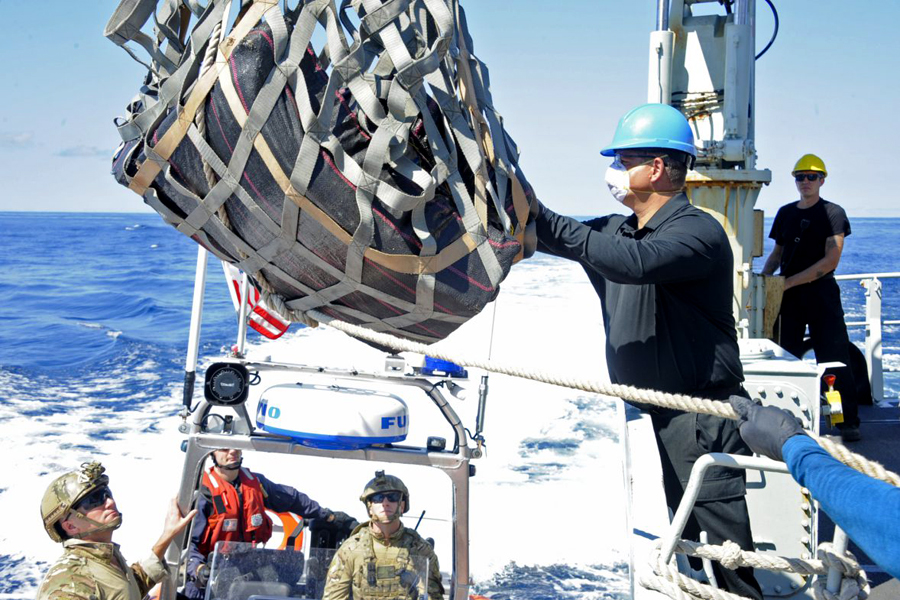HMC Ships Whitehorse, Edmonton make three drug busts
By Lookout on May 01, 2018 with Comments 0
Lt(N) Paul Pendergast, Canadian Joint Operations Command PAO ~
HMC Ships Whitehorse and Edmonton had a busy two weeks on Operation Caribbe, making three drug busts during that short time.
The ships assisted the United States Coast Guard (USCG) in seizing approximately 2,011 kilograms of cocaine and disrupting another estimated 845 kg, for a total of some 2,856 kg of cocaine that was prevented from reaching the streets of North America.
March 24
On March 24, Whitehorse helped the USCG seize about 30 kg and disrupt an estimated 845 kg of cocaine. This event took place in international waters in the eastern Pacific, off the coast of Central America.
A maritime patrol aircraft operating with Joint Interagency Task Force South (JIATF-S) spotted a suspicious vessel during a routine patrol. Whitehorse was tasked to stop the panga-style fishing vessel. It launched its rigid-hull inflatable boats (RHIBs), each with members of the embarked USCG Law Enforcement Detachment (LEDET).
The suspected smugglers on the panga-style vessel jettisoned approximately 875 kg of cocaine overboard and fled the scene. One of the RHIBs picked up a 30 kg bale of cocaine before joining the other RHIB in chasing the panga.
April 3
Stepping up to the plate on April 3, Edmonton assisted the USCG to seize about 461 kg of cocaine in international waters in the eastern Pacific off the coast of Central America.
An aircraft operating with JIATF-S spotted a suspicious vessel, and Edmonton was tasked to intercept it. When the ship was close enough, the Commanding Officer ordered the launch of their RHIBs with Edmonton crew and members of USCG LEDET onboard. They approached the panga-style vessel, which surrendered without chase. The USCG LEDET quickly boarded the suspected smuggler’s vessel and subsequently found 23 bales of cocaine weighing about 461 kg. The LEDET detained four crew members.
“I am proud of the efforts of the crew, and the embarked LEDET, but we cannot forget all the other support provided from personnel ashore to set the conditions for success on Operation Caribbe,” said Lieutenant-Commander Brian Henwood, Commanding Officer Edmonton.
April 5
Little did they know, the biggest bust was yet to come.
On April 5, Whitehorse helped the USCG to seize about 1,520 kg of cocaine in international waters in the eastern Pacific off the coast of Central America.
While on a routine patrol on Operation Caribbe, Whitehorse spotted a suspicious vessel by radar, and was tasked to intercept it by JIATF-S. When Whitehorse was close enough, they launched their RHIBs, each with members of the embarked USCG LEDET, who proceeded ahead of the ship.
Once in range, the crew of Whitehorse saw it was a 60-foot fishing vessel, holding a stationary position, with seven panga-style boats attached alongside. At this point, a puff of smoke was observed coming from their exhaust pipes, indicating that the fishing vessel was getting underway. The seven pangas scattered in multiple directions, erratically maneuvering away from the fishing vessel, some jettisoning objects as they went, and others deploying fishing gear.
The RHIBs pursued and intercepted the fleeing pangas, and, after about an hour, they had all returned to the fishing vessel. One of the RHIBs then began a search pattern to locate any contraband that may have been jettisoned by the pangas.
The RHIB Coxswain, a member of the Royal Canadian Navy who cannot be named for security reasons, describes how they found the drugs.
“We conducted a standard grid search around the vessel’s original position, while the other RHIB stayed with the pangas and the fishing vessel,” said the RHIB Coxswain. “After about 40 minutes, we were about to return to Whitehorse when we spotted fish jumping out of the water and birds flocking over them and decided to investigate. When we arrived at the spot we found six elongated bales floating in the water, each about 12 feet long, tied together with nets, with a long rope connecting them. As soon as we saw it we knew it was the cocaine.”
The LEDET seized the bales of cocaine weighing about 1,520 kg. They also detained 20 suspected smugglers.
“I commend the professionalism of this crew and the close cooperation between Whitehorse and the USCG LEDET which directly contributed to this success of this operation,” said Lieutenant-Commander Collin Forsberg, Commanding Officer Whitehorse. “The men and women of Whitehorse are proud to be a part of this important effort to keep illicit drugs off the streets of North America.”
Now on their way home to Esquimalt, Whitehorse and Edmonton have added another chapter to the success story of Operation Caribbe.
The Canadian Armed Forces has contributed to the seizure of more than 85 tonnes of cocaine since Operation Caribbe commenced in 2006 with the United States JIATF-S.
Filed Under: Top Stories
About the Author:






